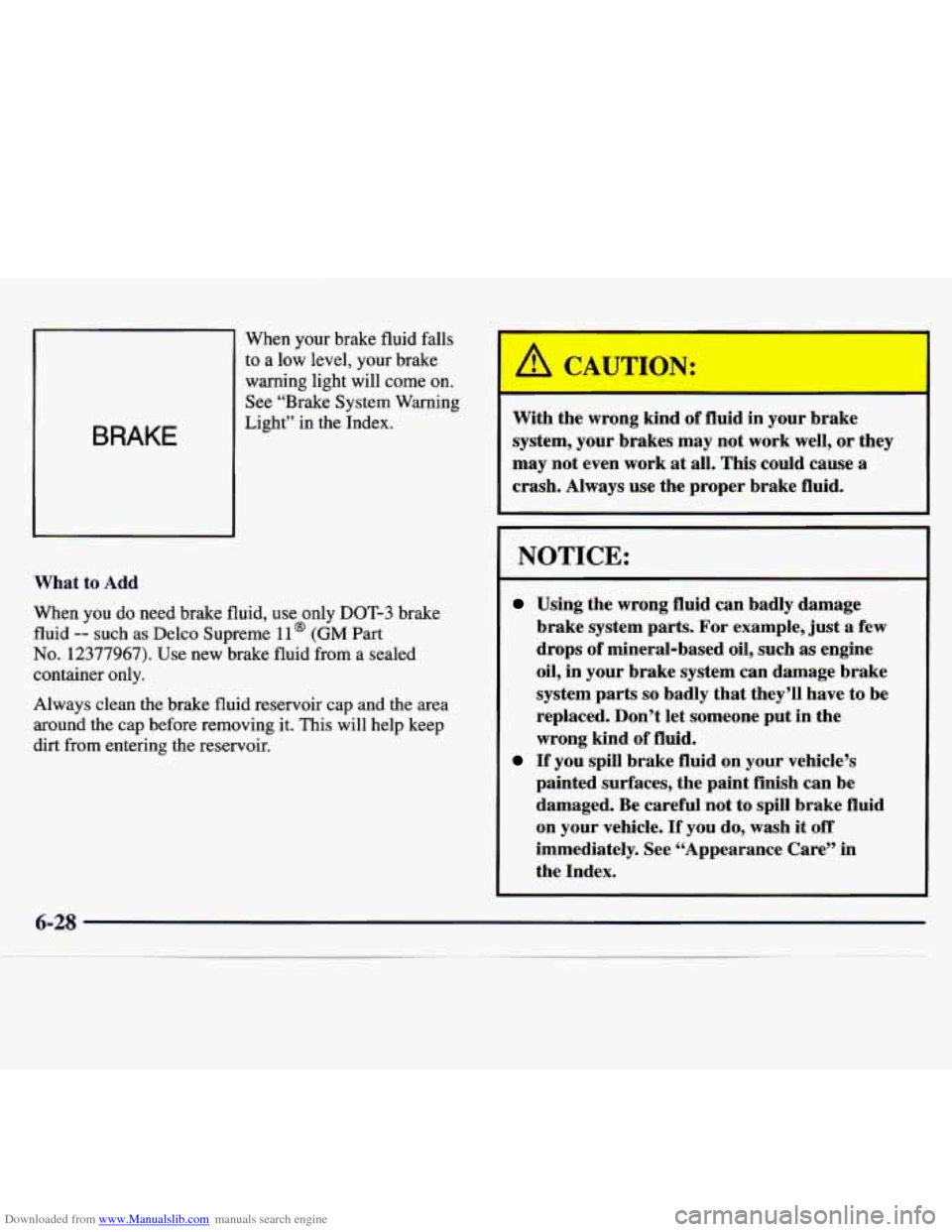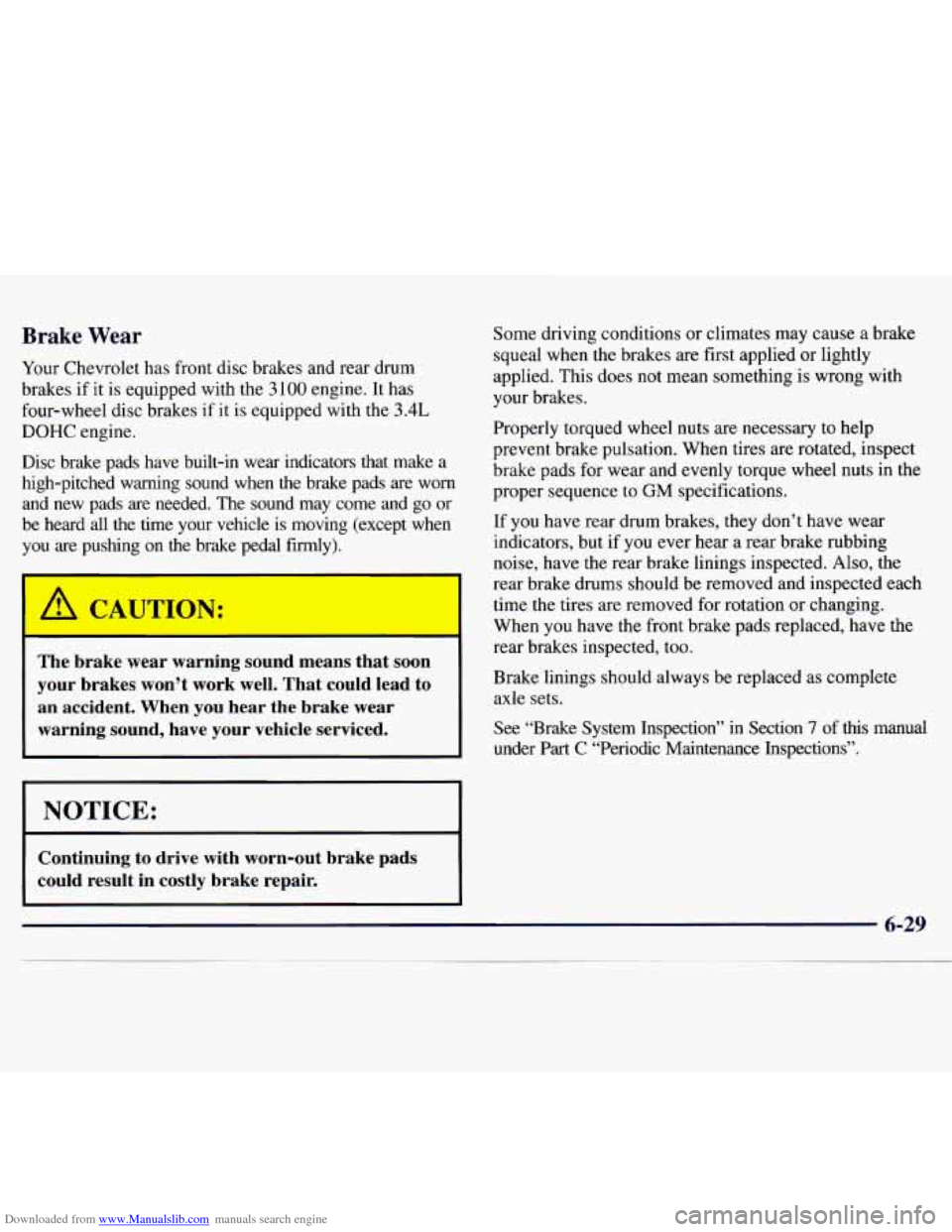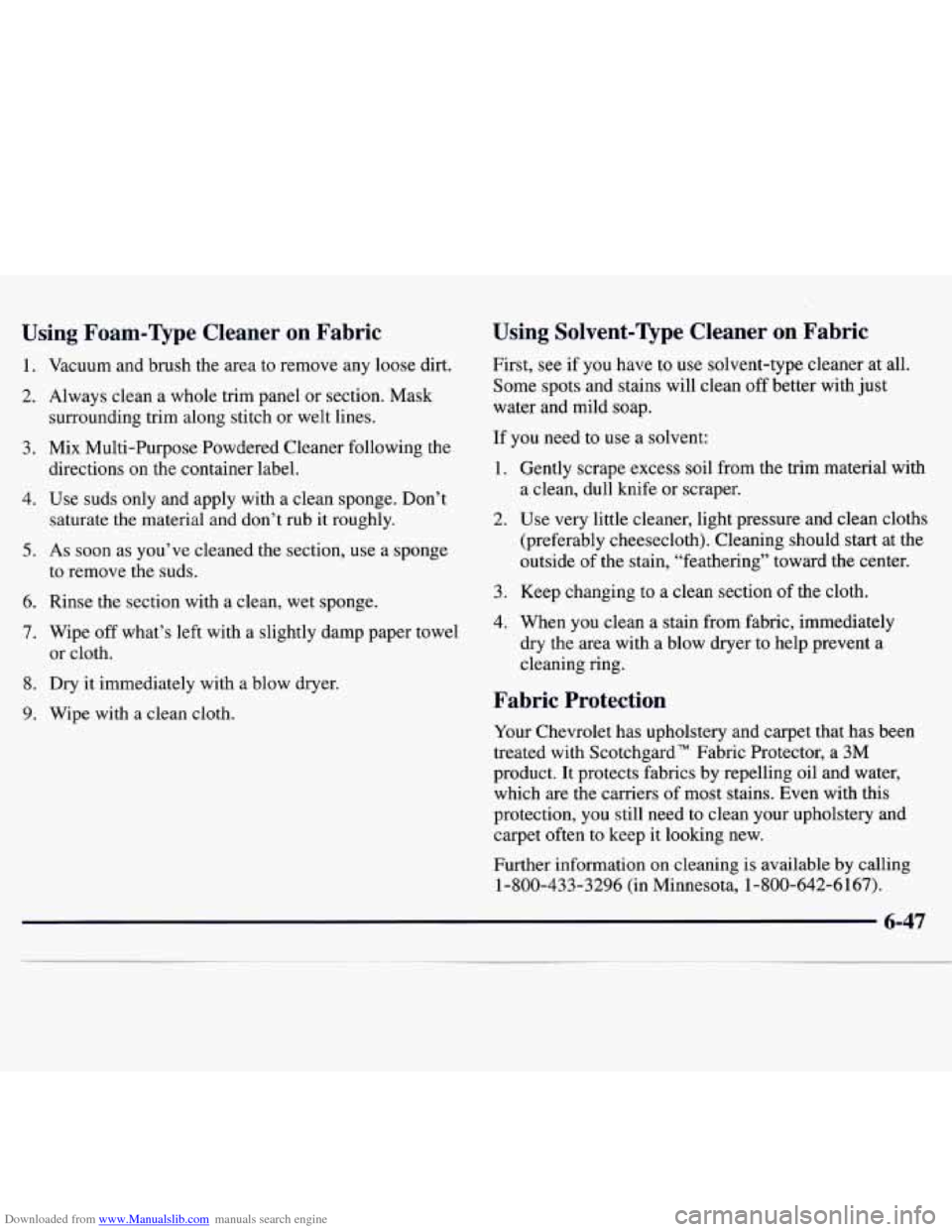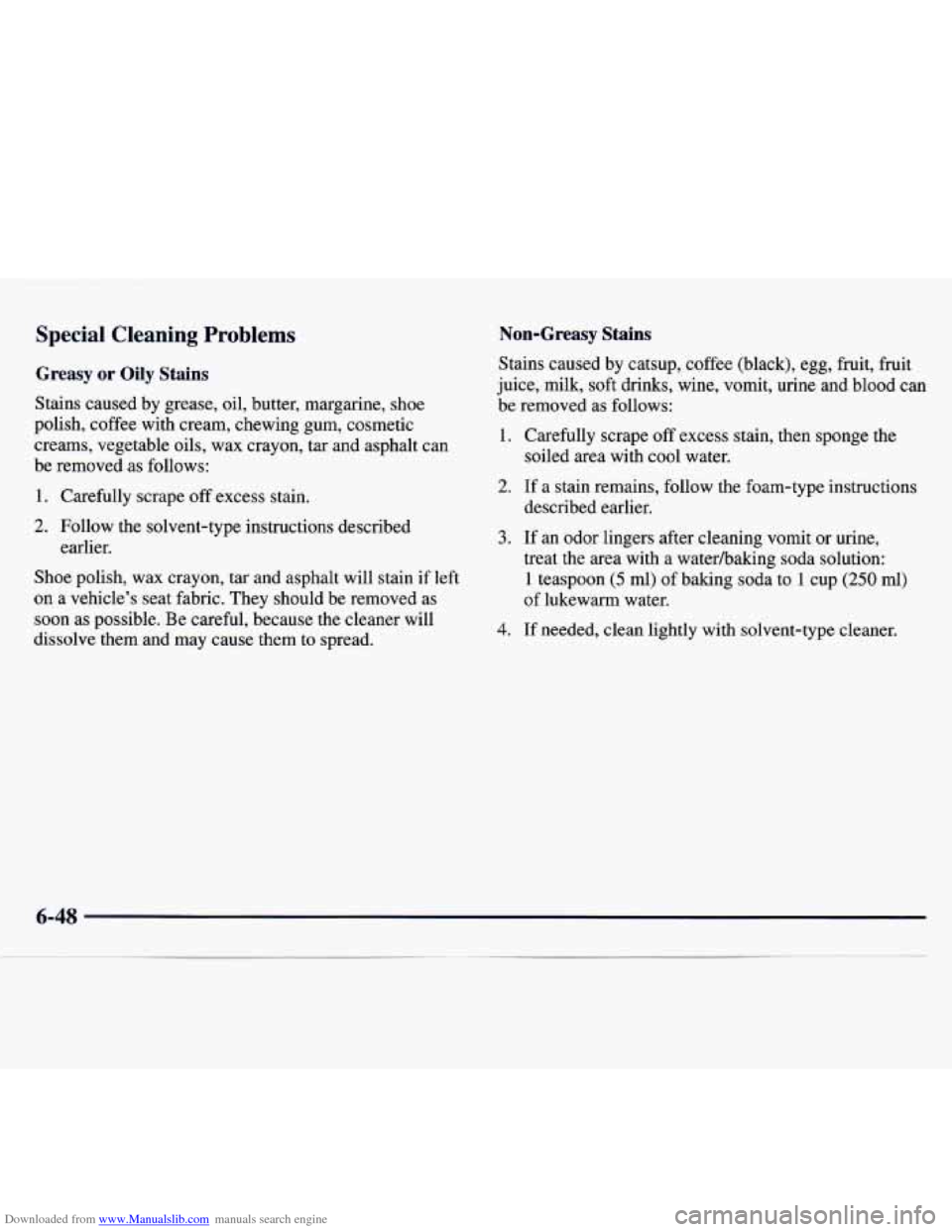Page 238 of 358
Downloaded from www.Manualslib.com manuals search engine LOW
COOLANT
If this light comes on,
it means you’re low
on
engine coolant.
Adding Coolant
If you need more coolant, add the proper DEX-COOL@
coolant mixture at the coolant recovery tank, but be
careful not to spill it.
If the coolant recovery tank is completely empty, add
coolant to the radiator. (See “Engine Overheating” in
the Index
.)
I /I CAUTION:
Thing the radiator pressure cap when tl,,
engine and radiator are hot can allow steam and
scalding liquids to blow out and burn you badly.
With the coolant recovery tank, you will almost
never have to add coolant at the radiator. Never
turn the radiator pressure cap
-- even a little --
when the engine and radiator are hot.
A CAUTION:
You can be burned if you spill coolant on hot
engine parts. Coolant contains ethylene glycol,
and
it will burn if the engine parts are hot
enough. Don’t spill coolant on a hot engine.
Page 243 of 358

Downloaded from www.Manualslib.com manuals search engine BRAKE
When your brake fluid falls
to a low level, your brake
warning light will come on.
See “Brake System Warning
Light” in the Index.
What to Add
When you do need brake fluid, use only DOT-3 brake
fluid
-- such as Delco Supreme 11 @ (GM Part
No. 12377967). Use new brake fluid from a sealed
container only.
Always clean
the brake fluid reservoir cap and the area
around the cap before removing it. This will help keep
dirt from entering the reservoir.
U
With the wrong kind of fluid in your brake
system, your brakes may not work well, or they
may not even work at all. This could cause
a
crash. Always use the proper brake fluid.
NOTICE:
Using the wrong fluid can badly damage
brake system parts. For example, just
a few
drops of mineral-based oil, such
as engine
oil, in your brake system can damage brake
system parts
so badly that they’ll have to be
replaced. Don’t let someone put in the
wrong kind
of fluid.
If you spill brake fluid on your vehicle’s
painted surfaces, the paint finish can be
damaged. Be careful not to spill brake fluid
on your vehicle.
If you do, wash it off
immediately. See “Appearance Care” in
the Index.
Page 244 of 358

Downloaded from www.Manualslib.com manuals search engine Brake Wear
Your Chevrolet has front disc brakes and rear drum
brakes if it is equipped with the
3 100 engine. It has
four-wheel disc brakes if it is equipped with the
3.4L
DOHC engine.
Disc brake pads have built-in wear indicators that make a
high-pitched warning sound when the brake pads are worn and new pads
are needed. The sound may come and go or
be heard all the time your vehicle is moving (except when
you
are pushing on the brake pedal firmly).
I
The brake wear warning sound means that soon
your brakes won’t work well. That could lead to an accident. When you hear the brake wear
warning sound, have your vehicle serviced.
I NOTICE:
Continuing to drive with worn-out brake pads
could result in costly brake repair.
Some driving conditions or climates may cause a brake
squeal when the brakes are first applied or lightly
applied. This does not mean something is wrong with
your brakes.
Properly torqued wheel nuts are necessary to help
prevent brake pulsation. When tires are rotated, inspect
brake pads for wear and evenly torque wheel nuts in the
proper sequence to GM specifications.
If
you have rear drum brakes, they don’t have wear
indicators, but if
you ever hear a rear brake rubbing
noise, have the rear brake linings inspected. Also, the
rear brake drums should be removed and inspected each
time the tires are removed for rotation or changing.
When you have the front brake pads replaced, have the
rear brakes inspected, too.
Brake linings should always be replaced as complete
axle sets.
See “Brake System Inspection” in Section 7 of this manual
under
Part C “Periodic Maintenance Inspections”.
Page 257 of 358

Downloaded from www.Manualslib.com manuals search engine Uniform Tire Quality Grading
The following information relates to the system
developed by the United States National Highway
Traffic Safety Administration, which grades tires
by
treadwear, traction and temperature performance. (This
applies only to vehicles sold in the United States.) The
grades are molded on the sidewalls of most passenger
car tires. The Uniform Tire Quality Grading system does
not apply to deep tread, winter-type snow tires,
space-saver
or temporary use spare tires, tires with
nominal rim diameters of
10 to 12 inches (25 to 30 cm),
or to some limited-production tires.
While the tires available on General Motors passenger
cars and light trucks may vary with respect
to these
grades, they must also conform to Federal safety
requirements and additional General Motors Tire
Performance Criteria (TPC) standards.
Treadwear
The treadwear grade is a comparative rating based on
the wear rate of the tire when tested under controlled
conditions on a specified government test course. For
example, a tire graded 150 would wear one and
a half
(1 1/2) times as well on the government course as a tire
graded
100. The relative performance of tires depends
upon the actual conditions
of their use, however, and
may depart significantly from the norm due to variations
in driving habits, service practices and differences in
road characteristics and climate.
Traction -- A, B, C
The traction grades, from highest to lowest, are A, B, and
C, and they represent the tire’s ability
to stop on wet
pavement as measured under controlled conditions on specified government test surfaces of asphalt and concrete.
A tire marked C may have poor traction performance.
Warning: The traction grade assigned to this tire is based
on braking (straightahead) traction tests and does not
include cornering (turning) traction.
Page 262 of 358

Downloaded from www.Manualslib.com manuals search engine Using Foam-Type Cleaner on Fabric
1.
2.
3.
4.
5.
6.
7.
8.
9.
Vacuum and brush the area to remove any loose dirt.
Always clean a whole trim panel or section. Mask
surrounding trim along stitch or welt lines.
Mix Multi-Purpose Powdered Cleaner following the directions on the container label.
Use
suds only and apply with a clean sponge. Don’t
saturate the material and don’t rub it roughly.
As soon as you’ve cleaned the section, use a sponge
to remove the suds.
Rinse the section with a clean, wet sponge.
Wipe off what’s left with a slightly damp paper towel
or cloth.
Dry it immediately with a blow dryer.
Wipe with a clean cloth.
Using Solvent-Type Cleaner on Fabric
First, see if you have to use solvent-type cleaner at all.
Some spots and stains will clean off better with just
water and mild soap.
If you need to use
a solvent:
1.
2.
3.
4. Gently scrape
excess soil from the trim material with
a clean, dull knife or scraper.
Use very little cleaner, light pressure and clean cloths
(preferably cheesecloth). Cleaning should start at the
outside
of the stain, “feathering” toward the center.
Keep changing to a clean section of the cloth.
When you clean a stain from fabric, immediately
dry the area with a blow dryer to help prevent a
cleaning ring.
Fabric Protection
Your Chevrolet has upholstery and carpet that has been
treated with Scotchgard” Fabric Protector, a 3M
product. It protects fabrics by repelling oil and water,
which are the carriers of most stains. Even with this
protection, you still need to clean your upholstery and
carpet often to keep it looking new.
Further information on cleaning is available by calling
1-800-433-3296 (in Minnesota, 1-800-642-61
67).
Page 263 of 358

Downloaded from www.Manualslib.com manuals search engine Special Cleaning Problems
Greasy or Oily Stains
Stains caused by grease, oil, butter, margarine, shoe
polish, coffee with cream, chewing gum, cosmetic
creams, vegetable oils, wax crayon, tar and asphalt can
be removed as follows:
1. Carefully scrape off excess stain.
2. Follow the solvent-type instructions described
Shoe polish, wax crayon, tar and asphalt will stain
if left
on a vehicle’s seat fabric. They should be removed as
soon as possible. Be careful, because the cleaner will
dissolve them and may cause them to spread.
earlier.
Non-Greasy StSlinc
Stains caused
by carsup, coffee (black), egg, fruit, fruit
juice, milk,
soft drinks, wine, vomit, urine and blood can
be removed as follows:
1. Carefully scrape off excess stain, then sponge the
soiled area with cool water.
2. If a stain remains, follow the foam-type instructions
described earlier.
3. If an odor lingers after cleaning vomit or urine,
treat the area with a waterhaking soda solution:
1 teaspoon (5 ml) of baking soda to 1 cup (250 ml)
of lukewarm water.
4. If needed, clean lightly with solvent-type cleaner.
Page 273 of 358
Downloaded from www.Manualslib.com manuals search engine Fuse
1
4
5
6
10
Circuit
Breaker
C
D
Description
11
12 Power Windows
Power Seats
13
Description
CIGAR LIGHTER -- Instrument
Panel and Console Cigar Lighters
HVAC
-- WAC Control
Assembly Solenoid Box,
Mix Motor, DRL Module,
HVAC Control Head, Blower
Control Switch
HAZARD FLASHER
R.H.
SPOT LAMP (S.E.O.)
I/P ELECTRONICS BATTERY
FEED
-- Chime Module,
Electronic Brake Control Module
(EBCM), Theft-Deterrent
Module, Radio
STARTER RELAY
ANTI-THEFTPCM
--
Theft-Deterrent Module
ABS
-- Electronic Brake Control
Module (EBCM), ABS Relay
Page 274 of 358

Downloaded from www.Manualslib.com manuals search engine Fuse
14
15
19
20 21 22
23
25 28
Description
HVAC BLOWER MOTOR --
Blower Motor Relay
L.H. SPOT LAMP
(S.E.O.)
Fuse
29
30
Description
WIPER -- Wiper Switch
TURN SIGNAL
-- TU^
Signal Flasher
POWER ACCESSORY (Power)
#I -- Door Lock Switches,
Trunk Courtesy Lamp, Power
Mirror Switch
POWER ACCESSORY #2
--
(Sunroof) Control Unit
AIR BAG
-- Air Bag System
CRUISE CONTROL
-- Cruise
Control Cut-Out Switch
STOPLAMPS
-- TCCBrake
Switch
ENGLISWMETRIC
(S.E.O.)
CTSY LAMPS -- Vanity Mirrors,
IR Compartment Lamp, Header
Courtesy and Reading Lamp,
US Lighted Rearview Mirror,
Dome
Lamp
32
33
37 POWER
LOCKS
-- Door Lock
Relay, Keyless Entry Receiver
DRL MODULE
REAR DEFOG
-- HVAC
Control Assembly Rear Window
Defogger Switch
38
39
41
42 RADIO
-- Radio, Steering
Wheel
Radio Switches, Power Drop
I/P ELECTRONICS IGNITION
FEED
-- Headlamp Switch,
TCCPBrake Switch, Instrument
Cluster, Chime Module, Keyless
Entry Receiver, BTSI Switch
POWER DROP
ENHANCED EVAP. SOLENOID